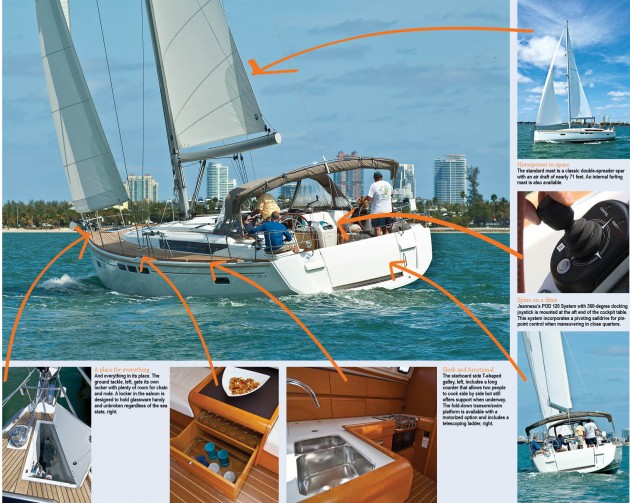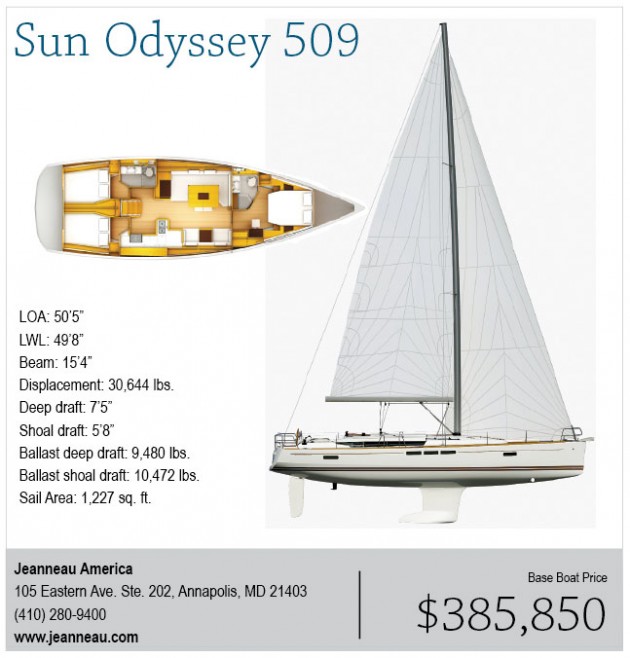Sun Odyssey 509
Born to run
With world class style in an affordable package, this latest performance cruiser is turning heads with its speed and grace
The new Jeanneau 509 may be the most intriguing boat yet from award-winning designer Philippe Briand. The 509 stretches standard design parameters and nudges the status quo without the need to broadcast the fact with a garish design statement that screams, "Look at me, I'm different." The 509 is a handsome boat that blends fresh thinking with respect for what makes a sailboat a sailboat: that essential mix of grace, power and utility.
The 509 hull is wedge shaped, the deck is low slung, and the lines are raked by a chine that accentuates the sleek overall profile. The boat looks fast tied to the dock, and not surprisingly, with a versatile sailplan and easily driven hull, it is fast on the water too. Briand is one of the few designers who also had a successful sailing career, winning several world championships in the 1980s. Naturally, you might expect a boat with such a clear performance pedigree to be stark or severe in a racy, northern European kind of way. No chance. The Jeanneau 509 is warm, almost excessively comfortable and thoroughly stylish. It is French after all.
I sailed the new 509 on Biscayne Bay after the Miami Boat Show. The conditions were ideal. That is, ideal for a lovely daysail with friends and family, not necessarily for putting a thoroughbred like the 509 through its paces. Alas, we were forced to make do with warm, 10- to 15-knot breezes and flat, shimmering seas. I dealt with the challenging conditions by reminding myself that I was just doing my job, and applied another coat of sunscreen.
The details
The 509 is the latest model and the current flagship in Jeanneau's long-running Sun Odyssey Series. Innovative and environmentally friendly manufacturing techniques have become Jeanneau trademarks. The 509's hull is solid fiberglass, supported by a counter molded structural grid that is laminated in place. The deck is injection molded using Jeanneau's proprietary, closed-molding "Prisma Process." End-grain balsa coring and ISO laminate materials are actually laid up dry before the mold is closed and sealed. The resin is then injected into the void. This technique allows for precise resin metering and laminate distribution. The result is a stronger, lighter deck without voids and one that is smoothly finished on both sides. The process also significantly reduces airborne volatile organic compounds, better for the atmosphere and for Jeanneau employees. 
The hull and deck are chemically and mechanically joined on a inward flange. Bulkheads are reinforced by the molded grid and also tabbed and laminated to the hull. The iron keel, which is available in a deep draft 7 feet 5 inches or shoal version of 5 feet 8 inches, is externally fastened. Jeanneau has genuinely figured out how to marry technology with tradition in the building process.
On deck
From the perspective of the helm, I was struck by the design of the 509's cockpit. The wheels are positioned well aft, literally just in front of the transom yet the visibility is terrific. The 509's hull shape is designed for great downwind sailing and easy surfing. To take advantage of this attribute, the wheel and the rudder should be as far aft as possible for the most responsive steering control. The sight lines are not marred by the superstructure of a deck saloon or a boxy cabin trunk, so the helmsperson has an unobstructed
forward view.
Each helm station is impressive with a large leather-wrapped wheel, room for a chartplotter or other instruments in well-protected pods under a stainless steel handrail. The aft end of the cockpit table can serve as a centerline mounting point for the bow thruster control and below that, for additional sailing instruments. Jeanneau's POD 120 System with 360-degree docking is optional and the joystick is also mounted at the aft end of the cockpit table. This system uses a pivoting saildrive for pinpoint control when maneuvering in close quarters. The engine controls are located on the starboard side.
The large cockpit features five lockers, with one specifically designed to house the optional generator. The bench seats are comfortable and the back rests high enough to offer support and sense of security when the going turns rough. The cockpit table is not only huge, but also serves as a foot support when heeled. The large fold-down transom/swim platform is available with a motorized option, and includes a telescoping ladder. A hot-and-cold water shower is also standard. The primary sheet winches are Harken 60.2s and many 509 owners will choose the optional electric winches. The sheet lead for the self-tacking headsail runs aft, as do the halyards and lifts. A fiberglass cover keeps the deck clean.
All deck hardware is Harken, including genoa tracks with ball bearing cars adjustable from the cockpit. Thankfully the 509 bucks the trend of short, almost useless, travelers, and the Harken big-boat traveler is fully functional. The performance option includes a German-style dual sheet for efficient mainsail control. The standard mast is a classic double-spreader spar with an air draft of nearly 71 feet. An internal furling mast is also available. Single-pod chainplates support the single upper and lower shrouds. Most headsail sheeting is done inside the shrouds so the lead angles are very tight. Three different sail package options are available. The standard plan includes Dacron sails, the performance plan includes tri-radial cut mylar/taffeta laminate sails, and the third option is to set the boat up with a self-tacking headsail.
The deck is easy to navigate in fair conditions, and I have no reason to suspect that it wouldn't be secure in heavy going as well. The nonskid is superb and when coupled with the optional teak deck provides excellent footing and, lets face it, looks great. The teak handrails are low, along the cabin trunk, and not all that accessible, but that's a function of the low-profile design. In keeping with theme, the deck hatches are flush mounted and a design feature that I haven't embraced just yet.
The aluminum mooring cleats are robust, and essential amidships cleats are included. Stainless cleats and a tack point reinforcement for the asymmetric sail are part of the Trim Level Premier upgrade package. The stainless steel double bow roller feeds the ground tackle into a deep chain locker. One option that I would definitely chose is the forward sail locker accessed through a deck hatch. This is a great storage area for large items, including sails, fenders and even a rolled up inflatable dinghy.
Down below
Three wide, gently sloping companionway steps deliver you below into a world of open space, honey-colored teak trim and natural light. The 509's interior is stunning. There are several different layouts available but I prefer the three-cabin, two-head model with a unique T-shaped galley to starboard. The galley in this model includes a long counter that allows two people cook side by side but still offers support when underway. Naturally, all the usual features are included, double stainless sinks, a two burner stove with oven and 12-volt refrigeration. Optional upgrades include a three-burner stove and keel cooler upgraded refrigeration and freezer. There is ample storage in upper storage lockers and a large deep storage locker aft with a removable plastic bin. A large head is opposite to port with a separate shower stall.
I eventually realized why the boat felt so comfortable and so accessible below: It is all on one level. There are not even door sills to step over and there are no awkward half steps to stumble over when moving about. It is a subtle design feature that makes a big difference both underway and when moored. The saloon includes a large C-shaped settee to port, with a table between with two additional chairs. Opposite is the lounge, two bucket-style seats with a pull-out bar/cabinet between. These seats are very comfortable and there is storage behind them. The surprisingly large and functional nav station is aft of the port settee with the blue backlit electrical panel above. The LED lighting throughout saves power and ventilation is adequate with two overhead hatches. Three fixed-hull portlights on each side add natural light that accents the matte finished light teak.
In this model, the owner's stateroom is forward and includes an island double berth, a wide hanging locker and an office/vanity desk with a clever movable stool. The ensuite head has a separate shower. The two aft cabins are side by side and feature double berths, small hanging lockers and plenty of storage. A port that opens into the cockpit and another overhead hatch keep these cabins from feeling too closed in.
Three different interior plans are also available. One, obviously for the charter trade, includes two side-by-side double cabins forward and aft and another includes a quarter cabin as a third aft cabin but maintains the forward owner's cabin. All of these plans sacrifice two of the 509s best features-the T-shaped galley, replacing it with a long galley lining the starboard side of the saloon, and nixes the lounge area.
The standard electrical system includes three 110-amp, 12-volt batteries but most owners will upgrade this capacity along with the standard 80-amp engine alternator. The plumbing system features 167 gallons of water in two roto-molded tanks, one under the forward berth and another under an aft berth. This is an adequate amount of water but again, many owners will consider adding a watermaker. There are water and fuel tank gauges on the electrical panel. Each bilge pump has separate hosing for overboard discharge through a dedicated through hull fitting, a definite safety feature.
A four-cylinder, turbo-charged, 75-horsepower Yanmar diesel is the standard power plant. This engine is one of the workhorses of the sailing industry, especially for boats in the 45- to 55-foot range. It's reliable, efficient, and parts and service are available worldwide. Engine access is from behind the companionway steps and through panels in the aft cabins. The 64-gallon roto-molded fuel tank is located under the starboard aft cabin berth. A fixed three-blade propeller is standard but I wouldn't hesitate to upgrade to the optional Flexofold folding prop.
Under sail
Back out on the bay, the 509 was finding its stride on a close reach. The helm was light and very well balanced. With the wind steady at 12 knots, we cut through the turquoise waters at 6.5 knots at 55 degrees apparent. Falling off 10 degrees, my friend Steve Maseda eased the sheets and we accelerated over 7 knots. I am not sure if it was just my imagination but it seemed like I could feel the chine bite in as we heeled. The effect seemed to retard heeling and the boat felt flat and fast. Hardening the sheets we pointed quite high, inside 40 degrees apparent before losing significant speed.
We executed several quick tacks and the 509 came through wind quickly and without much fuss, especially with the self-tacking headsail. Easing off onto a reach we could have used a downwind sail as our speed fell off. Still, I was quite impressed as we kept the boat moving with an improvised wing and wing maneuver. Fortunately, the wind backed and we had a lovely tight reach back toward the marina.
The Jeanneau 509 is proof that a production boat can also be a world-class sailboat. The fact that it is also a great value is just another reason to seriously consider the 509.

Comments